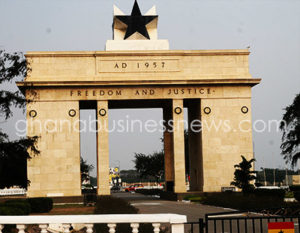Moody’s forecasts more than 6% growth for Ghana in second quarter 2017
 Ratings agency, Moody’s projects that Ghana’s economy will grow more than six per cent in the second quarter of 2017 as the country will benefit from the “continued development of the Tweneboa, Enyenra and Ntomme (TEN) oil field and production at the new Sankofa field.
Ratings agency, Moody’s projects that Ghana’s economy will grow more than six per cent in the second quarter of 2017 as the country will benefit from the “continued development of the Tweneboa, Enyenra and Ntomme (TEN) oil field and production at the new Sankofa field.
As at December 2016, the TEN field produced about 800,000 barrels of oil, and the gas export to the Gas Processing Plant (GPP) is expected to begin in the 1st quarter, 2017, a former Minister of Petroleum was reported to have said. The International Finance Corporation (IFC) and Multilateral Investment Guarantee Agency (MIGA), of the World Bank Group, also announced the commitment of $517 million in debt and guarantees to support the Sankofa Gas Project.
The significance of these two oil and gas projects cannot be overestimated as the country’s former Finance Minister, Seth Terkper has consistently said, when full production from these fields begin, the country’s economy as well as energy situation would stabilize.
Moody’s made the projection in its 2017 forecast of Sovereigns in sub-Sahara Africa report.
The agency states that the creditworthiness of sovereigns in the region has an overall negative outlook for 2017, reflecting the liquidity stress facing commodity-dependent countries, subdued economic growth, and persistent political risk.
According to Moody’s, the negative outlook for sovereign creditworthiness in 2017 in sub-Saharan Africa reflects its expectations for the fundamental credit conditions that will drive sovereign credit in this region over the next 12-18 months.
“Sub-Saharan Africa’s economies will continue to face commodity-induced liquidity stress in 2017, with recurring fiscal deficits amid challenging financing conditions,” Lucie Villa, a Moody’s Vice-President — Senior Analyst and co-author of the report was quoted as saying.
“These will remain important credit constraints and underpin our negative outlook for sub-Saharan Africa sovereigns overall,” Villa added.
According to Moody’s, the negative pressures on sub-Saharan Africa’s sovereigns were reflected in numerous negative rating actions in 2016. By the end of last year, it had downgraded a third of the region’s 19 rated sovereigns by an average of around two notches. This compares with 29 downgraded sovereigns globally (22 per cent of the 134 countries rated by Moody’s) by an average of slightly more than one notch, it said.
The Agency rated Ghana (B3 stable) after the government allayed near-term liquidity pressure by issuing a $750 million Eurobond to roll over a $400 million Eurobond maturing in October 2017.
“Risks have also declined as the fiscal deficit narrows, the balance of payments outlook improves and institutional reforms advance under an International Monetary Fund (IMF) programme,” Moody’s said.
Meanwhile, the IMF projected in December 2016, that Ghana’s economy would grow 7.5 per cent in 2017. The forecast was also based on expected TEN field full production.
By Emmanuel K Dogbevi
Copyright © 2017 by Creative Imaginations Publicity
All rights reserved. This news item, or any portion thereof may not be reproduced or used in any manner whatsoever without the express written permission of the publisher except for the use of brief quotations in reviews.
